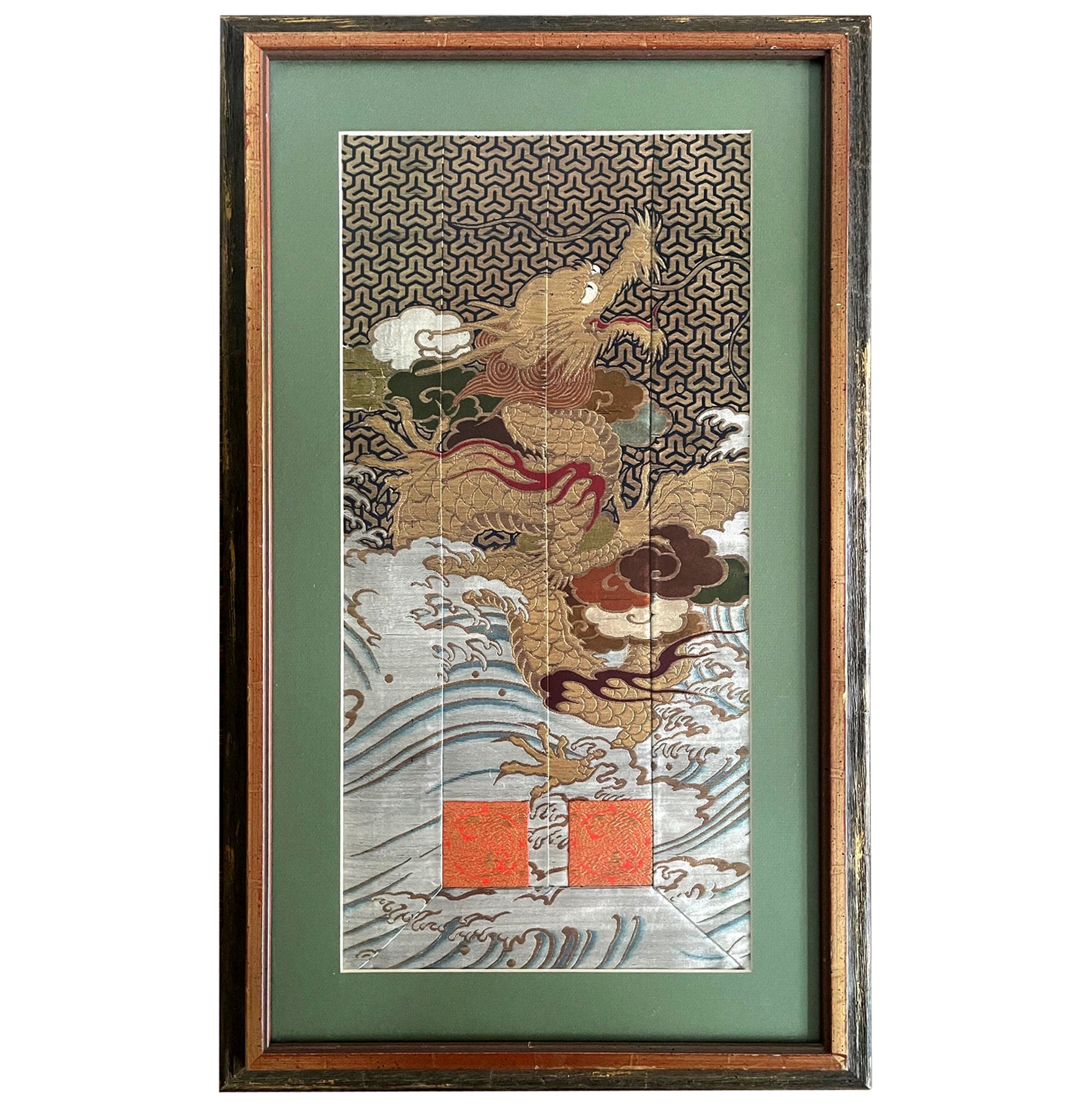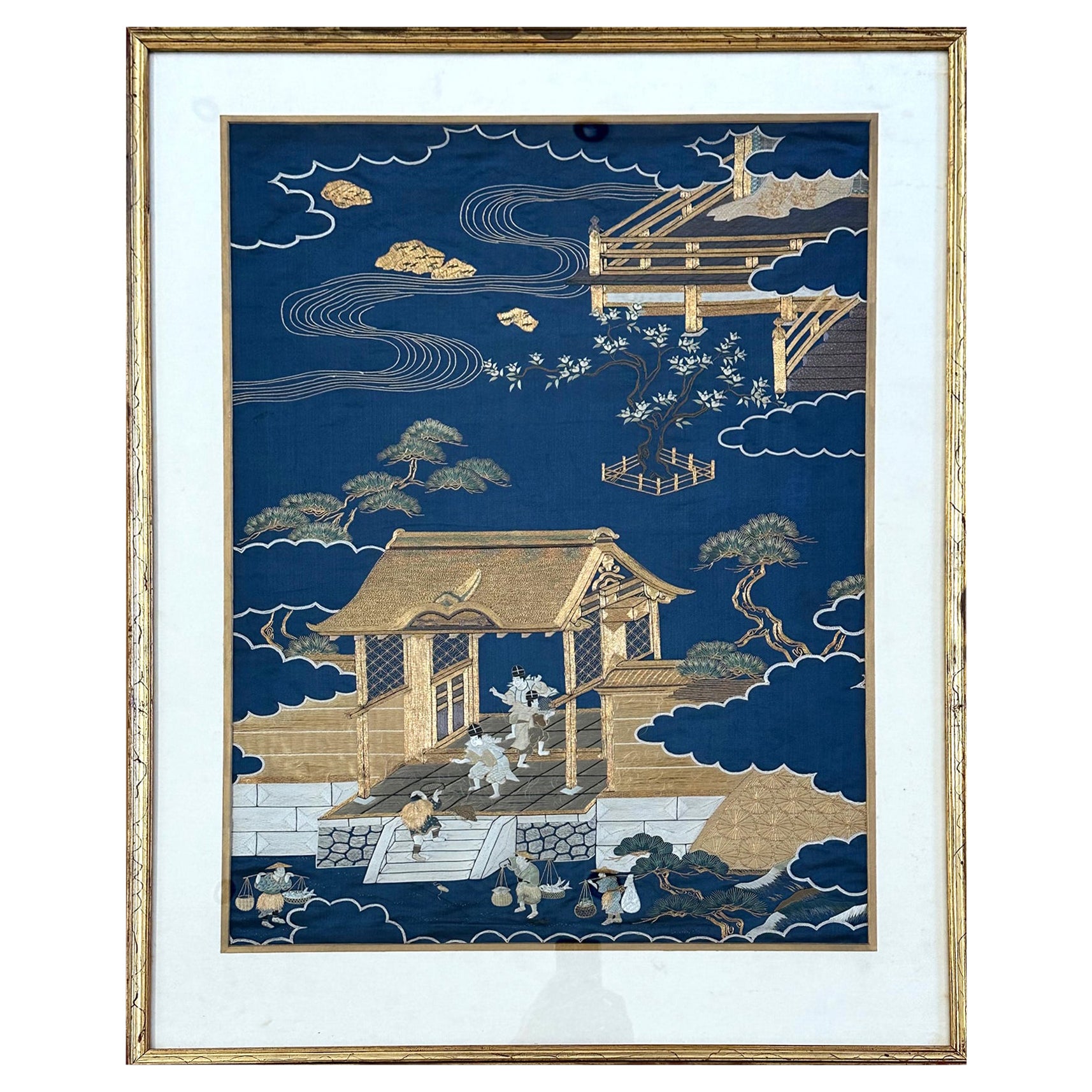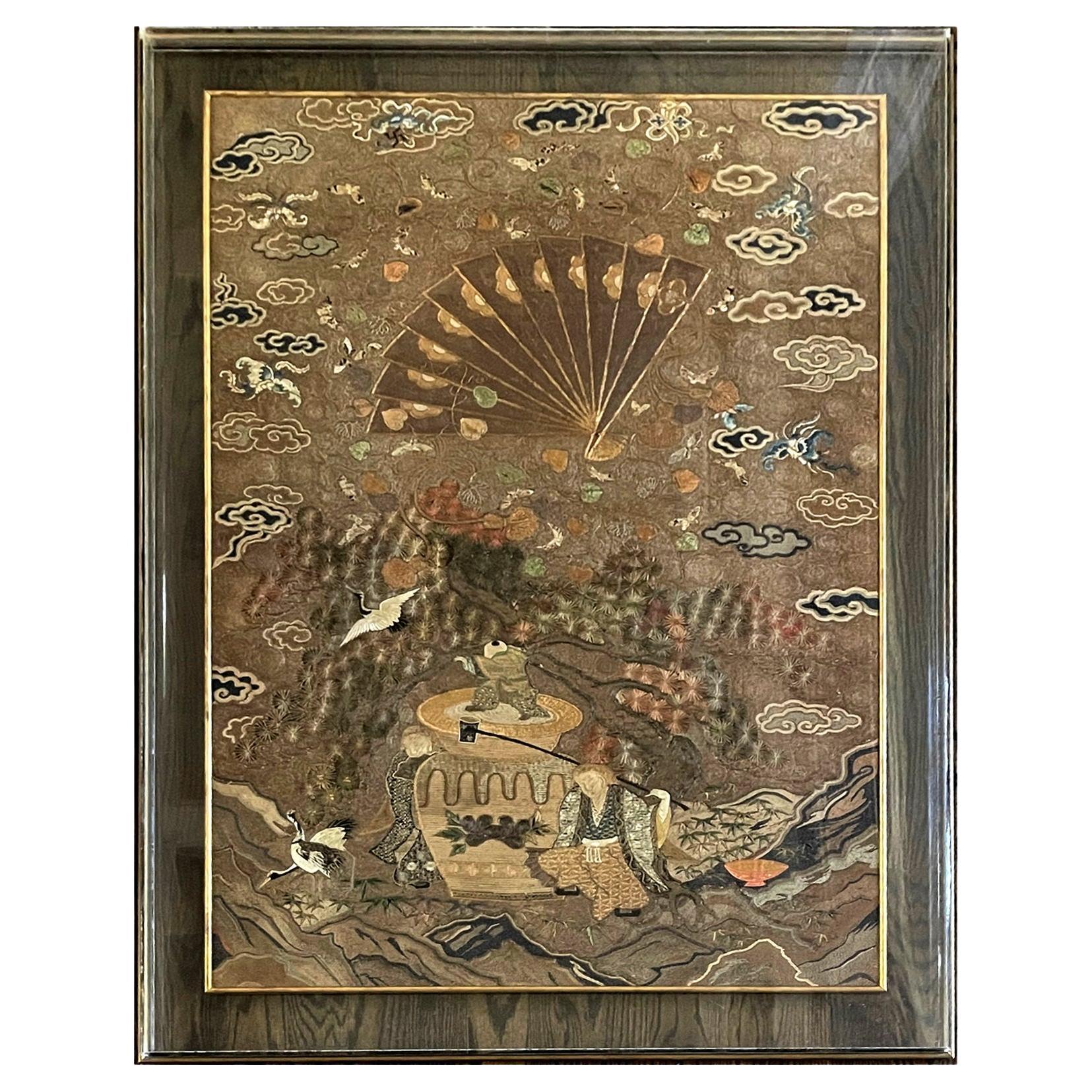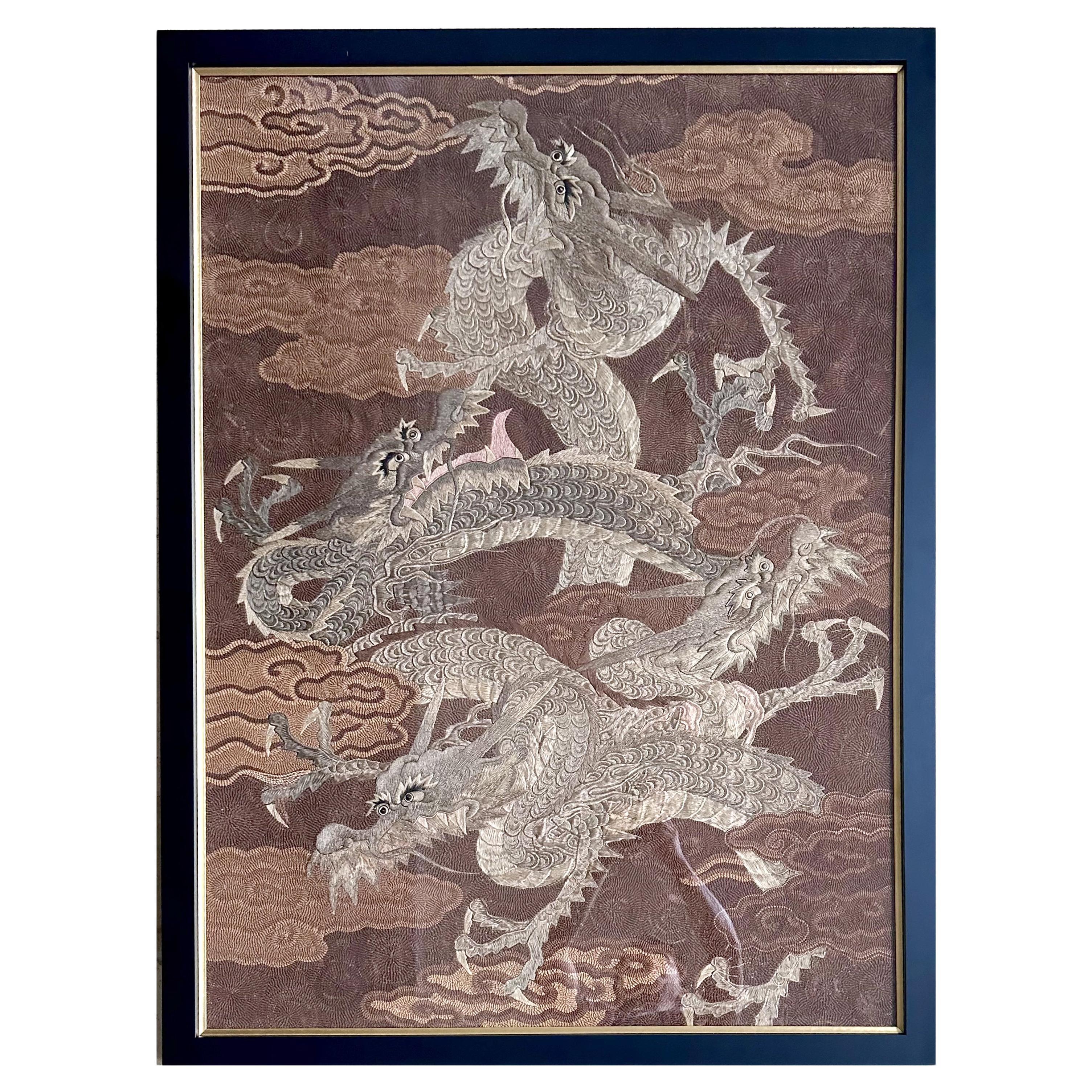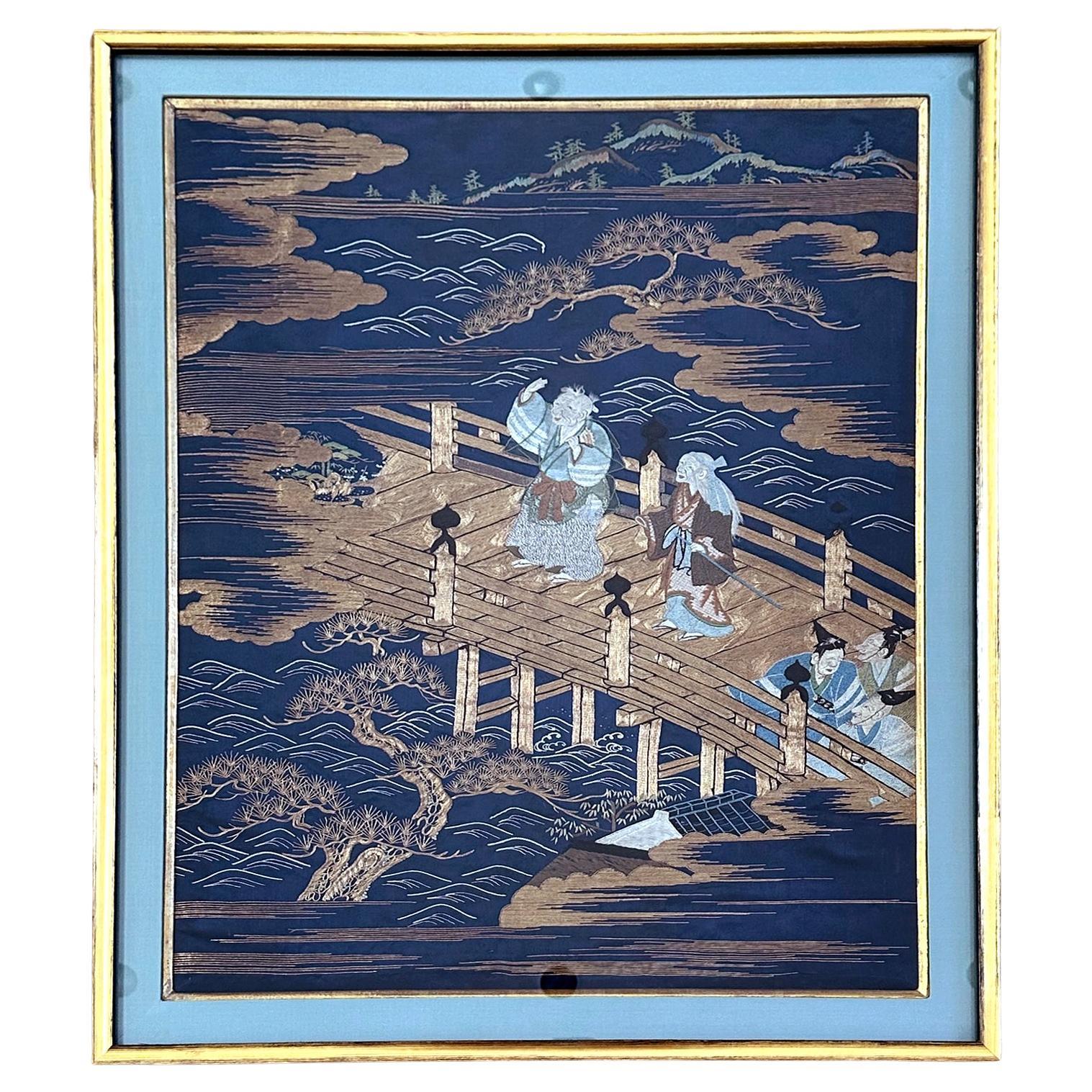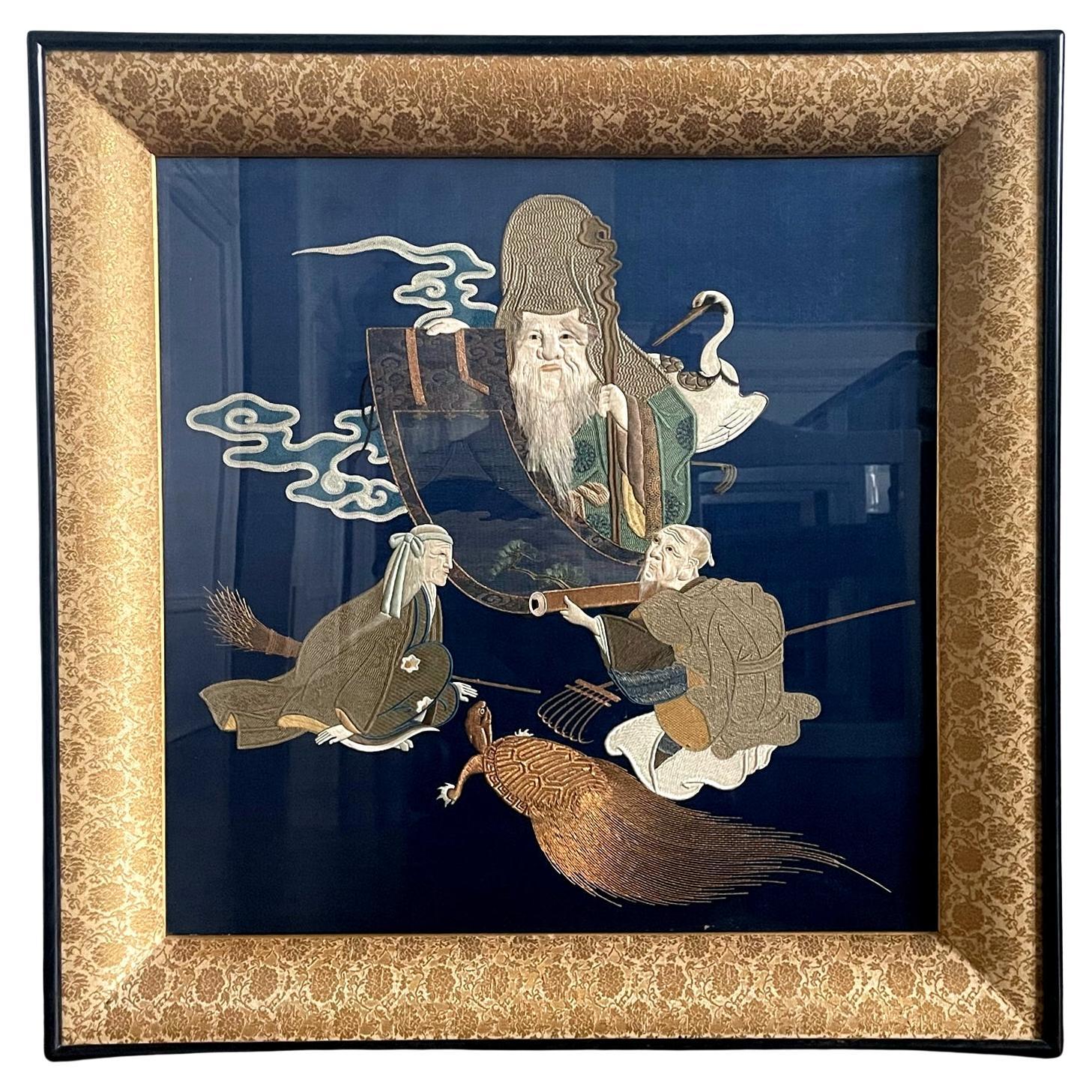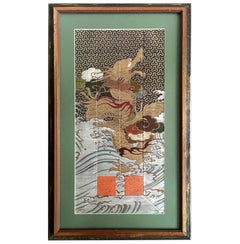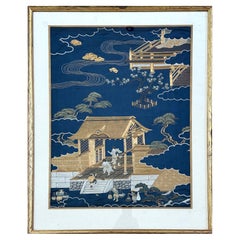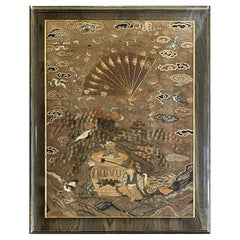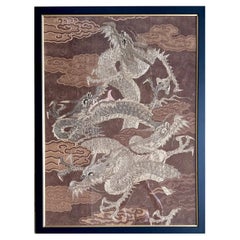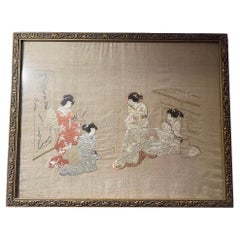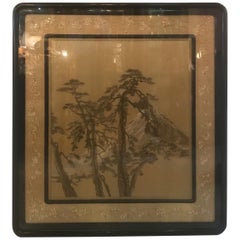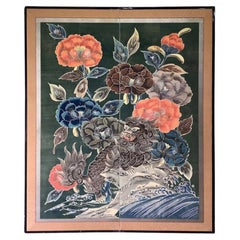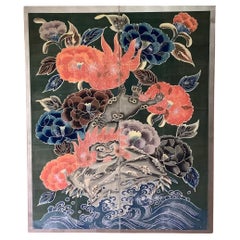Items Similar to Framed Japanese Antique Embroidery Sennin Tapestry Meiji Period
Want more images or videos?
Request additional images or videos from the seller
1 of 18
Framed Japanese Antique Embroidery Sennin Tapestry Meiji Period
$8,500
£6,498.70
€7,485.19
CA$11,911.11
A$13,297.63
CHF 6,967.76
MX$162,776.04
NOK 88,490.60
SEK 83,435.40
DKK 55,862.76
Shipping
Retrieving quote...The 1stDibs Promise:
Authenticity Guarantee,
Money-Back Guarantee,
24-Hour Cancellation
About the Item
A stunning Japanese embroidery tapestry circa 1880s-1900s from late Meiji period, presented with an original wood frame with inner gold trim. The tour-de-force embroidered tapestry showcases a dramatic pictorial in which Tekkai Sennin intertwines with a slithering dragon in the air and releases swirl spirit wind from his bottle. This scenery alludes to a deity adapted in Japan from the Chinese prototype called Li Tieguai. Literally translated as Li the Iron Crutch, he was one of the eight immortals in Chinese Taoism folklore. He is often depicted as a limp and disheveled old man walking on a crush and holding a Calabash gourd. In both Chinese and Japanese culture, he was beloved and worshipped due to his compassion for the poor and the sick as he used the medicine in his bottle to alleviate the pain of the diseased. In Japanese art, he was often depicted with holding his gourd bottle, from which a tornado like vapor emanates. The swirl clouds represent his own soul. Many paintings of such subject manner can be found in museum collections around the world.
The tapestry on offer was entirely hand-embroidered and the superb craftsmanship is evident with the first glimpse. The composition is striking and was painstakingly executed by the unknown artisans. The high relief effect, created by meticulous techniques such as satin stiches, couching and piling with layers of gold and silver wrapped threads, displays a harmonious composition while conveying a livid sense of motion (especially the swirling clouds). The attention to details was rather meticulous, down to the rendition of the background thatch houses, landscapes, trees by the stream, and the little medallions in the sky. It also appears that it was kept in very good condition under the frame. All these factors set the piece apart as a highly collectible textile art.
Japanese textiles from Meiji period were widely exhibited in the west during turn of the 20th century at the international expositions. It was used to showcase the Japanese aesthetics with the techniques at their pinnacle. These expositions solidified the country's images overseas and fueled the Japonisme craze in the west, which turned out to be a long-lasting influence on the western art. Many pieces were purchased and stayed in the west. It is likely this estate piece was from one of the expositions based on its high quality. Remanent of a paper label on the back as shown.
Japanese figurative embroidery tapestries are relatively less common. For a tapestry of Kari Sonja, see "Threads of silk and gold ornamental textile from Meiji Japan Ashmolean", page 97.
A tapestry of that depicts Badara Sonja see "Re-envisioning Japan Meiji Fine Art Textile, John E. Vollmer", page 90.
For detailed terminology of embroidery techniques used in this work, please refer to threads of silk and gold ornamental textile from Meiji Japan Ashmolean page 86-87.
- Dimensions:Height: 57 in (144.78 cm)Width: 38 in (96.52 cm)Depth: 1.2 in (3.05 cm)
- Style:Meiji (Of the Period)
- Materials and Techniques:
- Place of Origin:
- Period:
- Date of Manufacture:1880s-1910s
- Condition:Wear consistent with age and use. Textile appears very fine, not examined out of the frame. Frame shows age-related wear including minor nicks and scratches. Small punctures and scrapes on the backing paper.
- Seller Location:Atlanta, GA
- Reference Number:1stDibs: LU945036493992
About the Seller
4.9
Platinum Seller
Premium sellers with a 4.7+ rating and 24-hour response times
Established in 2006
1stDibs seller since 2010
565 sales on 1stDibs
Typical response time: <1 hour
- ShippingRetrieving quote...Shipping from: Atlanta, GA
- Return Policy
Authenticity Guarantee
In the unlikely event there’s an issue with an item’s authenticity, contact us within 1 year for a full refund. DetailsMoney-Back Guarantee
If your item is not as described, is damaged in transit, or does not arrive, contact us within 7 days for a full refund. Details24-Hour Cancellation
You have a 24-hour grace period in which to reconsider your purchase, with no questions asked.Vetted Professional Sellers
Our world-class sellers must adhere to strict standards for service and quality, maintaining the integrity of our listings.Price-Match Guarantee
If you find that a seller listed the same item for a lower price elsewhere, we’ll match it.Trusted Global Delivery
Our best-in-class carrier network provides specialized shipping options worldwide, including custom delivery.More From This Seller
View AllFramed Japanese Woven Textile Panel with Dragon Meiji Period
Located in Atlanta, GA
A framed Japanese woven textile circa late 19th century of Meiji Period. Likely a fragment of a priest robe or kesa, the multi-paneled textile was finely woven with gold foiled threads that depicts a five-clawed dragon slithering in the clouds and water...
Category
Antique 19th Century Japanese Meiji Textiles
Materials
Silk, Wood
Framed Antique Japanese Embroidery Fukusa Textile Panel
Located in Atlanta, GA
A Japanese silk Fukusa Panel housed in a gilt frame circa late 19th century of Meiji Period. Fukusa is a traditional Japanese textile art used as a wrap for presenting gifts at important occasions. On the deep blue background, the elaborate embroidery work depicts a historical scene where street vendors selling goods to a royal household or an aristocratic residence. The scene focuses on the activities at the front gate where the couriers and servants were busying carrying the goods in. A peasant with straw coat...
Category
Antique Late 19th Century Japanese Meiji Textiles
Materials
Silk, Wood
Japanese Silk Embroidery Tapestry Meiji Period
Located in Atlanta, GA
A spectacular Japanese embroidered silk panel beautifully presented in a gilt frame suspended in a lucite shadow box with gilt wood border. The silk picture is dated to 1890-1910s toward the end of Meiji Period, when Japanese started to participate international expose by presenting its best art and craft. Elaborate embroidered silk tapestry like this was very popular among westerners due to its superb craftmanship and also exotic subject matter that was often derived from classic Japanese folklore, mythology and various motifs. The tapestry on offer is such an example. It depicts an old couple...
Category
Antique 1890s Japanese Japonisme Textiles
Materials
Fabric, Silk, Lucite
Framed Japanese Embroidery Dragon Tapestry Meiji Period
Located in Atlanta, GA
A striking Japanese embroidery tapestry circa 1890s Meiji period presented in a gilt wood frame under glaze. The design features four dragons coiling and slithering in the clouds. The most auspicious mythological creature, dragon was a very popular motif in Japanese textile art. Viewing this particular piece, one is struck by the superb craftsmanship with the profuse use of silver threads in satin stitches and complex chain stich coiling that create the background. The slight relief technique was also used on parts of the dragon heads, rendering the piece a strong sense of dimension and motion. The textile itself measures about 32.5"x46".
Japanese Meiji textiles were widely exhibited in the west during turn of the 20th century at the international exposition. It was used to showcase the Japanese aesthetics with the techniques at their pinnacle. These expositions solidified the country's images overseas and felled the Japanese craze in the west, which turned out to be a long-lasting influence on the western art. Many pieces were purchased and stayed in the west. As there is no brocade border present, the piece is likely the main part with the central motifs of a larger tapestry and was later framed for display.
For two similar dragon tapestries...
Category
Antique 1890s Japanese Meiji Textiles
Materials
Textile, Wood
Framed Antique Japanese Embroidery Fukusa Panel Takasago Legend
Located in Atlanta, GA
A finely embroidered Japanese silk Fukusa panel presented in a beautiful silk-lined giltwood frame (newly framed and glazed), circa late 19th century of Meiji Period. Fukusa is a traditional Japanese textile art used to wrap and present gifts at important occasions. Depending on the occasion, the panel itself can be a very fine textile art on its own.
On the deep blue background, this elaborate textile art depicts an old couple standing on a bridge with three bystanders, flanked by pine trees with hills afar. The couple is Jotomba (Joo and Uba are their respective names), characters in the Legend of Takasago, one of the oldest Japanese mythologies, who are associated with old pines. The legend goes as: "At Takasago Shrine there is a very old pine tree, the trunk of which is bifurcated; in it dwells the spirit of the Maiden of Takasago who was seen once by the son of Izanagi who fell in love and wedded her. Both lived to a very great age, dying at the same hour on the same day, and since then their spirits abide in the tree, but on moonlight nights they return to human shape to revisit the scene of their earthly felicity and pursue their work of gathering pine needles. His pine tree is called “The Pine of Suminoe” while hers is "Takasago pine".
In Japan, Takasago couple...
Category
Antique Late 19th Century Japanese Meiji Textiles
Materials
Silk, Wood
Framed Antique Japanese Embroidery Fukusa Panel
Located in Atlanta, GA
A finely embroidered Japanese silk Fukusa panel presented in a beautiful brocade-wrapped fame. Circa late 19th century of Meiji Period, Fukusa is a traditional Japanese textile...
Category
Antique Late 19th Century Japanese Meiji Textiles
Materials
Silk, Wood
You May Also Like
Mid-20th Century Japanese silk embroidered framed painting
Located in Delft, NL
Mid-20th Century Japanese silk embroidered framed painting
A silk embroidered painting and is framed behind glass with a scene of women in ...
Category
Mid-20th Century Japanese Paintings and Screens
Materials
Silk
Antique Early 20th Century Japanese Hand Stitched Silk Framed Tapestry
Located in Lambertville, NJ
All hand work framed silk Japanese tapestry with embroidered boarder. A deep custom black lacquered frame. Originaly sold from Newman Galleries....
Category
Early 20th Century Japanese Meiji Textiles
Materials
Silk, Glass, Lacquer
Late Edo period Tsutsugaki 筒描 Auspicious Shishi Batik Screen
Located in Fukuoka, JP
Auspicious Shishi Batik Screen
Period: Late Edo
Size: 145x173 cm (57x68 inches)
SKU: PTA62
Step into the mythical world of late Edo Japan with our radiant batik screen depicting the...
Category
Antique 19th Century Japanese Edo Paintings and Screens
Materials
Cotton, Wood
Late Edo period Tsutsugaki 筒描 Auspicious Shishi Batik Screen
Located in Fukuoka, JP
Auspicious Shishi Batik Screen
Period: Late Edo
Size: 145x173 cm (57x68 inches)
SKU: PTA62
Step into the mythical world of late Edo Japan with our radiant batik screen depicting the...
Category
Antique 19th Century Japanese Edo Paintings and Screens
Materials
Cotton, Wood
Handmade Late 19th Impressive Early Japanese Woven Tapestry
Located in Pasadena, CA
Step into the world of exquisite craftsmanship with this Handmade Late 19th Century Japanese Woven Tapestry, a rare and remarkable piece that reflects the elegance and artistry of an...
Category
Antique Late 19th Century Japanese Tapestries
Materials
Silk
Japanese Antique Silk and Cotton Tapestry
Located in Milano, IT
Wonderful and very rare Japanese tapestry made in the 1900s, made of woven silk and cotton, of absolute fineness.
The tapestry is developed in length ...
Category
Antique Early 1800s Japanese Japonisme Decorative Art
Materials
Fabric, Silk
$2,658 Sale Price
25% Off
More Ways To Browse
Framed Textile
Meiji Period Furniture
Framing Antique Textiles
Embroidery Framed
Meiji Wood
Meiji Wood Furniture
Silk Embroidery Frame
Japanese Labels
Japanese Embroidery
Gold Thread Embroidery
Antique Gold Embroidery
Framed Japanese Textiles
Meiji Silk
Meiji Dragon
Japanese Embroidered
Japanese Iron Meiji
Antique Chinese Tapestry
Silk Gold Thread Embroidery
